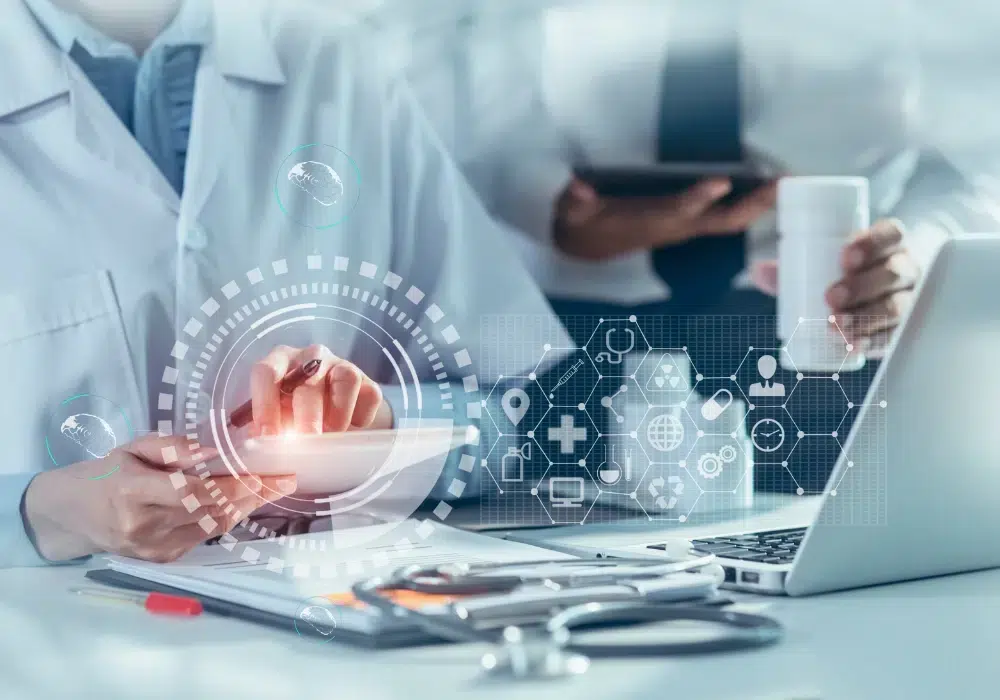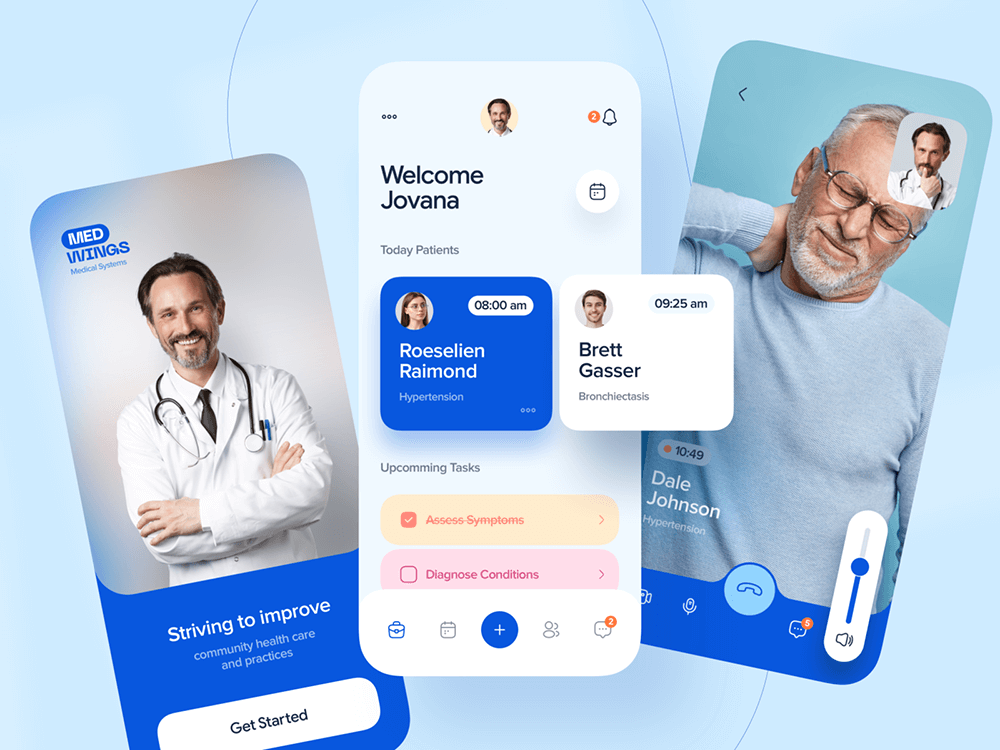Hospital Information Management Systems: Revolutionizing Healthcare Operations
According to HIMSS, hospitals that integrate advanced information management systems can reduce administrative workload by up to 30% and improve clinical outcomes by approximately 20% (HIMSS). These figures highlight the crucial role of Hospital Information Management Systems in modern healthcare.
A Hospital Information Management Systems (HIMS) is no longer optional; it’s a cornerstone for streamlining operations, enhancing care quality, and ensuring compliance. Healthcare providers face increasing demands for operational efficiency, cost reduction, and improved patient experiences. These challenges make adopting cutting-edge HIMS critical. Partnering with an experienced software development company is key to creating systems tailored to these needs. Savvycom, a leader in software outsourcing in Vietnam, has empowered hospitals with HIMS solutions that enhance operational efficiency and reduce costs.
This article delves into the essential features of HIMS and the transformative impact it can have on healthcare delivery, backed by real-world examples and statistics. Let’s explore how HIMS is transforming healthcare operations globally.

Hospital Information Management Systems (HIMS)
Understanding Hospital Information Management Systems
Hospital Information Management Systems (HIMS) are comprehensive digital platforms designed to manage various aspects of hospital operations. They integrate data from patient registration, electronic health records (EHR), appointment scheduling, billing, and resource management into a centralized system. HIMS provide real-time access to critical information, enabling healthcare professionals to make data-driven decisions that enhance patient care and streamline administrative processes.
At its core, HIMS aim to:
- Improve Data Accessibility: Centralizing patient records and operational data.
- Enhance Coordination: Facilitating seamless communication among departments.
- Optimize Resource Allocation: Enabling efficient management of hospital resources.
- Ensure Regulatory Compliance: Adhering to standards such as HIPAA, GDPR, and PCI DSS.
These systems are fundamental in transforming traditional, paper-based operations into efficient, digital workflows that support continuous improvement and innovation in healthcare.
Key Features of Hospital Information Management Systems
Real-Time Data Integration and Analytics
A major advantage of Hospital Information Management Systems is their ability to aggregate and analyze data in real time. By integrating information from various sources, such as EHR, laboratory systems, and appointment scheduling software, HIMS provide dynamic dashboards that display vital performance metrics. This real-time data integration enables hospitals to monitor patient flow, track resource utilization, and make informed decisions quickly. Research from HIMSS indicates that hospitals utilizing integrated information systems can reduce administrative tasks by up to 30% (JoSS).
Comprehensive Electronic Health Records (EHR) Integration
One of the core components of HIMS is EHR integration. A unified EHR system ensures that all patient data, including medical history, test results, and treatment plans, are stored securely and accessed easily by healthcare professionals. This comprehensive integration improves the accuracy of clinical decision-making and enhances continuity of care. Deloitte reports that integrating EHR with HIMS can improve care coordination by 20% (EmedHub).
Automated Workflow and Scheduling
HIMS streamline daily operations through automated workflows that handle patient registration, appointment scheduling, and resource management. Automation minimizes manual errors, reduces processing times, and ensures that all tasks are completed efficiently. This leads to shorter wait times, more effective patient scheduling, and improved overall efficiency.
- Example: Hospitals that have implemented automated scheduling in HIMS report a 25% reduction in patient wait times, leading to enhanced patient satisfaction.
Robust Security and Compliance
Security is paramount in healthcare data management. Hospital Information Management Systems come equipped with advanced security features such as encryption, secure access controls, and continuous monitoring to protect sensitive patient information. These systems help healthcare providers comply with regulatory standards like HIPAA and GDPR, ensuring data integrity and patient privacy.
- Data Point: According to the Ponemon Institute, robust security measures in healthcare IT systems can reduce data breaches by up to 50% (Ponemon Institute).
Interoperability and Integration with Legacy Systems
Modern HIMS are designed to seamlessly integrate with existing hospital infrastructure, including legacy systems and third-party applications. This interoperability ensures a smooth flow of data across all platforms, reducing information silos and enabling a unified approach to patient care.
- Insight: Integrated systems facilitate improved decision-making and operational efficiency by providing a holistic view of hospital operations.

Benefits of Hospital Information Management Systems
Enhanced Patient Care and Clinical Outcomes
By providing clinicians with immediate access to comprehensive patient data, HIMS improve diagnostic accuracy and treatment planning. This leads to better patient outcomes, enhanced care coordination, and a higher overall quality of care.
Operational Efficiency and Cost Savings
Automating routine administrative tasks reduces manual workloads, minimizes errors, and lowers operational costs. Hospitals can reallocate saved resources to direct patient care, ultimately leading to improved efficiency and reduced overhead expenses.
Data-Driven Decision Making
Real-time analytics and reporting tools within HIMS enable hospital administrators to monitor key performance indicators (KPIs) and make informed, data-driven decisions. This enhances resource management, helps identify areas for improvement, and supports strategic planning.
Improved Collaboration Across Departments
HIMS break down communication barriers by centralizing data and making it accessible to all relevant departments. This fosters collaboration between clinicians, administrators, and support staff, leading to coordinated efforts and improved patient care.
Scalability and Future-Proofing
As hospitals expand and evolve, HIMS offer scalable solutions that grow with the organization. This flexibility ensures that the system remains effective in managing increasing patient volumes and adapting to new regulatory requirements, thereby providing long-term value.
Get in touch with Savvycom for a free consultation. We’ll help you decide on next steps, explain how the development process is organized, and provide you with a free project estimate.
Real-World Case Studies on Hospital Information Management Systems
Case Study 1: Optimizing Patient Management in a Metropolitan Hospital
Background:
A major metropolitan hospital was struggling with fragmented patient data and inefficient administrative processes, which led to long wait times and inconsistent patient care.
Solution:
The hospital implemented an advanced HIMS that integrated EHR, appointment scheduling, and patient tracking into a unified platform. Real-time dashboards and automated workflows streamlined the patient management process and enhanced data accuracy.
Results:
- 30% reduction in patient wait times.
- 25% improvement in data accuracy and care coordination.
- 20% increase in overall operational efficiency.
This case highlights how HIMS can transform patient management, leading to significant operational improvements and better clinical outcomes.
Case Study 2: Enhancing Efficiency in a Regional Healthcare Network
Background:
A regional healthcare network faced challenges with managing multiple departments and disparate data systems, leading to inefficiencies and high administrative costs.
Solution:
The network deployed a comprehensive HIMS that centralized data from various sources, including EHR, billing, and scheduling systems. The integrated platform provided real-time analytics that allowed administrators to monitor performance and optimize resource allocation.
Results:
- 25% reduction in administrative overhead.
- 20% improvement in patient data accuracy.
- 15% increase in operational performance and compliance.
Centralized data management and real-time analytics significantly enhance operational efficiency and reduce costs, as demonstrated by this healthcare network’s transformation.
Case Study 3: Improving Clinical Outcomes with Integrated HIMS
Background:
A specialized healthcare facility needed to improve clinical decision-making and streamline inter-departmental communication to manage complex treatment protocols.
Solution:
The facility implemented a tailored HIMS that integrated patient records, diagnostic data, and treatment plans. This integration enabled real-time data sharing and collaboration among clinicians, improving the accuracy and timeliness of clinical decisions.
Results:
- 20% improvement in clinical decision-making accuracy.
- 15% reduction in treatment delays.
- Significant boost in patient satisfaction and care quality.
Integrated HIMS not only optimize administrative operations but also have a direct, positive impact on patient care and clinical outcomes.
Future Trends in Hospital Information Management Systems
1. Integration with AI and Machine Learning
The integration of AI and machine learning into HIMS will enhance predictive analytics, automate routine tasks, and optimize resource allocation. AI-driven insights can forecast patient admission trends and improve clinical decision-making, potentially boosting operational efficiency by up to 20%.
2. Expansion of Cloud-Based Solutions
Cloud computing is set to further revolutionize HIMS by offering scalable, flexible, and cost-effective solutions. Cloud-based systems enable real-time data access and seamless integration with other hospital IT systems, reducing infrastructure costs by up to 20%.
3. Enhanced Interoperability and Integration
Future HIMS will focus on improving interoperability between various healthcare systems, such as EHR, HIS, and patient management platforms. This seamless integration will provide a unified view of patient data, enabling better care coordination and more efficient operations.
4. Increased Emphasis on Cybersecurity
With the rise in cyber threats, HIMS will incorporate more advanced security measures, including end-to-end encryption and continuous monitoring, to protect sensitive patient data. Robust cybersecurity is essential for maintaining regulatory compliance and safeguarding patient privacy.
5. Adoption of IoT and Wearable Technologies
The integration of IoT devices and wearable technologies with HIMS will provide real-time monitoring of patient health, enabling more proactive care and better clinical outcomes. This trend will further drive the need for advanced data analytics and predictive maintenance in healthca
FAQs: More about Hospital Information Management Systems
How does HIMS improve patient care?
HIMS enhances patient care by offering:
- Accessibility: Doctors and staff can access up-to-date patient records from anywhere.
- Error Reduction: Automated systems minimize errors in prescriptions and treatments.
- Faster Response Times: Real-time alerts for critical patient conditions improve emergency care.
- Personalized Treatment: AI-driven analytics help craft individualized treatment plans.
How secure is patient data in a HIMS?
Modern HIMS platforms are designed with robust security protocols, including:
- Data Encryption: Protects sensitive information during storage and transmission.
- Role-Based Access Control: Ensures only authorized personnel access specific data.
- Regular Audits: Tracks data usage and prevents breaches.
Compliance with standards like HIPAA and GDPR ensures adherence to global data protection regulations.
How long does it take to implement a HIMS?
The implementation timeline depends on the system's complexity and the hospital's size. Typically, small to medium-sized hospitals require 6-12 months for deployment, including training and integration. Larger hospitals may need longer due to more extensive customization and data migration needs.
Conclusion: Driving Innovation in Healthcare with Hospital Information Management Systems
A robust Hospital Information Management System is integral to modernizing healthcare delivery. From centralized patient data to telemedicine integration, the benefits are undeniable.
Savvycom empowers healthcare providers to implement high-performance HIMS that drive efficiency, improve patient outcomes, and reduce costs. Ready to revolutionize your healthcare operations? Contact Savvycom today for a free consultation.
For an overview look at how technology is reshaping healthcare, watch this video:
Tech Consulting, End-to-End Product Development, Cloud & DevOps Service! Since 2009, Savvycom has been harnessing digital technologies for the benefit of businesses, mid and large enterprises, and startups across the variety of industries. We can help you to build high-quality software solutions and products as well as deliver a wide range of related professional services.
Savvycom is right where you need. Contact us now for further consultation:
- Phone: +84 24 3202 9222
- Hotline: +1 408 663 8600 (US); +612 8006 1349 (AUS); +84 32 675 2886 (VN)
- Email: [email protected]



